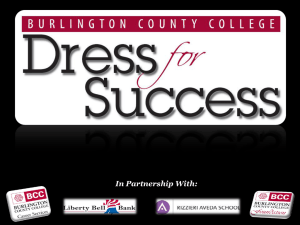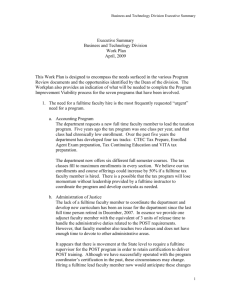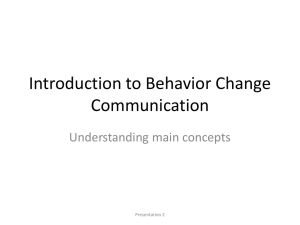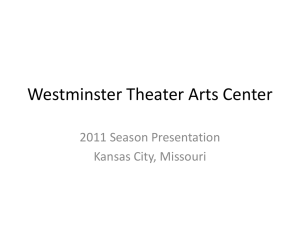Music - Berkeley City College
advertisement
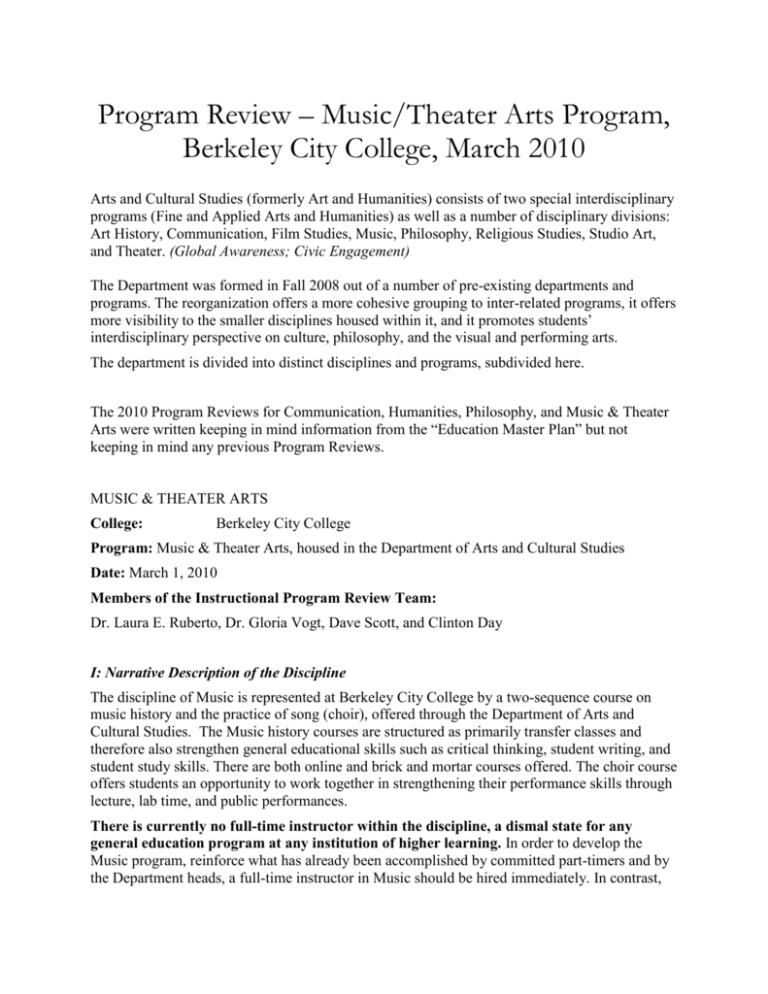
Program Review – Music/Theater Arts Program, Berkeley City College, March 2010 Arts and Cultural Studies (formerly Art and Humanities) consists of two special interdisciplinary programs (Fine and Applied Arts and Humanities) as well as a number of disciplinary divisions: Art History, Communication, Film Studies, Music, Philosophy, Religious Studies, Studio Art, and Theater. (Global Awareness; Civic Engagement) The Department was formed in Fall 2008 out of a number of pre-existing departments and programs. The reorganization offers a more cohesive grouping to inter-related programs, it offers more visibility to the smaller disciplines housed within it, and it promotes students’ interdisciplinary perspective on culture, philosophy, and the visual and performing arts. The department is divided into distinct disciplines and programs, subdivided here. The 2010 Program Reviews for Communication, Humanities, Philosophy, and Music & Theater Arts were written keeping in mind information from the “Education Master Plan” but not keeping in mind any previous Program Reviews. MUSIC & THEATER ARTS College: Berkeley City College Program: Music & Theater Arts, housed in the Department of Arts and Cultural Studies Date: March 1, 2010 Members of the Instructional Program Review Team: Dr. Laura E. Ruberto, Dr. Gloria Vogt, Dave Scott, and Clinton Day I: Narrative Description of the Discipline The discipline of Music is represented at Berkeley City College by a two-sequence course on music history and the practice of song (choir), offered through the Department of Arts and Cultural Studies. The Music history courses are structured as primarily transfer classes and therefore also strengthen general educational skills such as critical thinking, student writing, and student study skills. There are both online and brick and mortar courses offered. The choir course offers students an opportunity to work together in strengthening their performance skills through lecture, lab time, and public performances. There is currently no full-time instructor within the discipline, a dismal state for any general education program at any institution of higher learning. In order to develop the Music program, reinforce what has already been accomplished by committed part-timers and by the Department heads, a full-time instructor in Music should be hired immediately. In contrast, the fulltime contract faculty in music at our sister school, College of Alameda, filled his load in the Fall 2009 by teaching in our program—while we continued to also hire three part-timers with full loads as well. This further supports the need for a BCC fulltime music instructor. The Theater Arts courses have in the last 2 years been begun to be offered again after an unknown number of years when they were not offered. Currently, only one course a semester is offered and the state of the budget might require this course being temporarily cut. The class enrollment was growing each semester and the Theater Arts students had begun working with the multimedia/video production students. This collaboration cannot continue if the program is cut without being given an opportunity to grow. BCC is located in the heart of Berkeley, a rich and vital cultural center. BCC’s music and theater arts program is positioned to be an important part of this area’s cultural activities but this cannot happen without a fulltime contract faculty to support the program and outreach. Music courses at BCC are also part of the Liberal Arts AA degree. There is a growing link between BCC and the Jazz School as well. The Music 15A/15B courses fulfill the Ethnic Studies requirements for the AA/AS degrees. Recommendations -A full-time hire is needed immediately. -Continue to create collaborations with local performance spaces and other music locations -Increase the courses offered in music and theater arts; create and articulate new courses. II: Curriculum The Music curriculum is current and effective, reflecting recent trends within the large discipline of Music and keeping in mind the changing needs of BCC’s student body (by for instance, offering more distant education sections of courses). Music Fall semester offerings generally include: 3-4 sections of Music 15A 2-3 sections of Music 15B 1 section of Music 20 Music Spring semester offerings generally include: 3-4 sections of Music 15A 2-3 sections of Music 15B 1 section of Music 20 Music Summer offerings generally include: 1 section of Music 15A NOTE TO ABOVE: ALL COURSES are offered across different times of the day and week, as well as in a combination of brick and mortar and online courses, thus assuring access to the greatest variety of students. Budget cuts have decreased the number of sections taught in the last year. Recommendations - To standardize our course content and provide consistency in our approaches and evaluation at each course level, it is imperative that we hire more fulltime instructors. Part-time teachers, many of whom work at several campuses, cannot participate in many of the department’s activities and discussions where rubrics and standards are developed. The Music Program needs the stability and availability of fulltime contract faculty. -Additional courses developed and offered in each section of the curriculum . -Complete the course outline review of all courses and determine if any courses need to be updated or deactivated. Complete the outstanding SLOs that need to be written and begin assessment. 3. Instruction A unique and important part of the curriculum in BCC’s music program is its focus on the significance of African Americans’ contributions to America’s music. Jazz, it can be said, is America’s only indigenous music, and it came from a unique blend of both European (white musical traits and tradition) and African (black traits and tradition) cultures. It is neither solely European nor solely African, it is indeed American. This is what makes jazz unique, and it only could have happened in America. This is why the 15A and B classes are not only a study of music history, but a study in the ethnic and social history of America, including the history of black music in America (including blues and rock and roll). And a study of the music also reveals many facts about the culture. It is also why they fulfill the Ethnic Studies requirements for the AA/AS degrees. What is so significant for BCC’s Music program is that the study of the music within African American culture, and its significance historically, parallels the study of the history of race relations and Civil Rights as well. BCC also offers a Choir Program, which has grown at a rapid rate over the last year and a half. The Choir frequently performs publically, especially at BCC events (graduation, African American History Month, etc.). BCC has an innovative and progressive approach to music education that is reinforced by classroom techniques that engage the entire student. Faculty are committed to incorporating the use of video and audio technology within the classroom. (It should go without saying that the online courses are all interactive and offer learning across multiple mediums). The “smart” rooms in the new BCC building make it much easier to incorporate new technology and multimedia into the classroom. Teaching at other off-site locations (the “annex” or at UC Berkeley) can make such multi-media use in the classroom challenging. Multiple sections of the same course are offered at different times of the day/week (as well as through distant education) in order to meet the needs of students with diverse schedules. Faculty maintain an active dialogue with other music instructors at local colleges and universities. The part-time instructors are a distinguished team of professional musicians –all are Bay Area professionals who are active in the music community as performers as well as teachers. They all remain active in their respective scholarly disciplines beyond their work at BCC. The program has created a prioritized list in order to evaluate part-timers, as per the PFT contract. The music part-time instructors have all completed their evaluation process or are in the middle of completing it. All part-time instructors currently teaching will be evaluated by the end of Spring 2010. ENROLLMENT: Since 2004-05, enrollment has increased dramatically from 304 to 477 (census enrollment). In order to build upon this growth a fulltime contract hire is needed. Recommendations: - A fulltime, contract instructor is needed to support the existing curriculum and see the program grow. It is a dismal state for any general education program at any institution of higher learning not to have a fulltime music instructor. - Music instructors should be encouraged to stay active in their fields and take advantage of any available funding (staff development) to attend discipline-specific conferences or enroll in disciplinary professional associations, etc. - Music instructors should be encouraged to incorporate new media and new pedagogical methods into their teaching through proper administrative support of such training and implementation. - The program should meet more regularly, even informally among instructors teaching similar subjects, in order to exchange ideas and teaching approaches. 4. Student Success: Review of attached data shows the following trends: Productivity rates decreased substantially in the last four years due to a drastic change in the format of the classes. Previously, the courses were taught with very high enrollment caps (of 100), thus creating productivity rates of 40); with a change in the cap as well as a significant change in the pedagogical approach of the course—turning the course into a more serious academic course, has come still very high (numbers at about 21, 22, etc.) productivity rates, but within a norm, for a highly successful program. Persistence rates have fluctuated between 63% and 75%. Success rates are currently at an all-time high of 78.6% and have always remained above 67%. This dramatic increase can be directly correlated to the academic change in how the courses are offered—by decreasing the number of students (to standard caps of 40) in the classroom and increasing the academic rigor of the curriculum, the result has been higher success rates. Students feel more engaged and are learning more. STUDENT LEARNING OUTCOMES have been written for Music 15A and 15B and need to be written for the Choir and Theater Arts courses. (see taskstream) The course outlines need to be reviewed. Assessment of the courses or the program has not begun yet. Recommendations. - Complete the SLOs and begin assessment. -Review all course outlines -Work with counselors to better connect students to appropriate courses - Improve the marketing of the course offerings. 5. Human and Physical Resources (including equipment and facilities) There is no contract faculty in Music and there are currently 4 part-time faculty. The part-time faculty are a distinguished team of professional musicians who teach for us—all are Bay Area professionals who are active in the music community as performers as well as teachers. In order to support growth, develop the program and a major, a fulltime contract faculty is needed. In contrast, the fulltime contract faculty in music at our sister school, College of Alameda, filled his load in the Fall 2009 by teaching in our program—while we continued to also hire three part-timers with full loads as well. This further supports the need for a BCC fulltime music instructor. Appropriate space is needed for the choir to hold lectures, meet and practice. Similarly, although the new building has aided the effectiveness of Music teaching, it is problematic for instructors to teach off-site, due to the lack of adequate technology access. Recommendations - Our key staffing issue continues to be the lack of a contract instructor; we need to add one contract faculty immediately. -We would like adequate office space for both fulltime and part-time instructors. 6 . Community Outreach and Articulation The Program in Music ensures that the curriculum responds to the needs of the constituencies that it serves by keeping into close communication with the four-year public and private universities within our service area. BCC is located in the heart of Berkeley, a rich and vital cultural center. BCC’s music and theater arts program is positioned to be an important part of this area’s cultural activities but this cannot happen without a fulltime contract faculty to support the program and outreach. Much more can be done collaboratively between such places as the Jazz School , Freight and Salvage, or Berkeley’s theater district. Since the majority of our instructors teach part-time at other colleges and universities, they bring those experiencing to BCC as well. Recommendations -Continue to find ways to collaborate and dialogue with four-year universities, community organizations, high schools, and private institutions.
